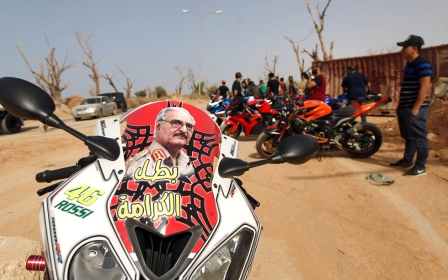Libyan militia building mercenary air force, rivals claim

Forces loyal to the Libyan renegade military commander Khalifa Haftar claim foreign mercenaries are being recruited to bolster the air power of rival fighters in the city of Misrata.
Colonel Ahmed Almesmari, of Haftar's Libyan National Army, said this week that the 11 mercenaries had entered the city, including "nine jet technicians from Ecuador, one Ukrainian pilot, one missile expert from Georgia".
A source close to the international mission in Libya, who asked to remain anonymous, also confirmed this to Middle East Eye. Almesmari told MEE that the Libyan National Army (LNA) was "not in a stage to comment further".
"In case we decide to announce detailed info, it will be on our official outlets," he added.
The mercenaries were reported by MEE's source to have entered the cities of Misrata and Mitiga.
The hiring of mercenaries would break UN resolutions on arms control in Libya.
Clashes between the LNA and militias loyal to the Government of National Accord (GNA) erupted in mid-April with the former aiming to seize control of towns close to Libya's northern coast.
This is not the first time that Misrata, which is controlled by pro-GNA militias, has used mercenary services for the piloting and maintenance of its aircraft fleet.
In early 2015, the Misrata-based Libya Dawn Air Force (LDAF) managed to make operational both of its Mirage F1s, but their pilots then refused to "bomb Libyan people".
The two Mirages flew to Malta in February 2011 during the Libyan uprising, when rebels overthrew the government of Muammar Gaddafi.
They were piloted by two senior officers, Ali al-Rabti and Abdullah al-Salheen, who claimed to have defected after being ordered to bomb civilians protesting in Benghazi.
The jets returned to Okba Ben Nafi air base near Tripoli in February 2012.
From February 2015, the Ukrainian Glissada company, specialising in the supply of spare parts for airplanes and helicopters of various nations, began looking for pilots and technicians with experience on the Mirage F1 for full-time jobs in Africa.
The final client was Libya Dawn, via the Caravana Middle East company based in Jordan and directed by a US-Jordanian, Rami Ghanem Najm, according to MEE's source. Najm was arrested in December 2015 in Greece on an international arrest warrant and extradited to the US on arms trafficking charges.
The first two foreign mercenaries appeared in Misrata in June 2015. One of them refused to bomb LNA troops and left. The other – an Ecuadorian, reinforced by technicians of the same country - carried out several air strikes against LNA forces, then Islamic State militants in the Sirte region.
Since 2016, the LDAF sided with the new, internationally recognised government in Tripoli, established in December 2015 and unanimously approved by the UN Security Council.
A lack of spares, maintenance personnel and pilots resulted in the LDAF being reduced to one operational Mirage F1, and about 10 other fighter jets by April 2016.
Mirage maintenance is complicated, as many spares were captured by the LNA when it took control of al-Watiya airbase in northwest Libya in 2014.
On 3 June 2016, the sole operational Mirage crashed west of the city of Sirte due to a technical problem. The pilot, a Portuguese mercenary, ejected, but died of his injures.
By the end of July, a lack of money meant that all foreign mercenary pilots and engineers had left Libya, leaving the LDAF with only a few operational pilots and aircraft.
Since the beginning of April, Misrata has been engaged in a trial of strength with the LNA in the Fezzan region.
The LNA air force launched multiple air strikes on Tamanhint air base, 30km northeast of al-Sebha, where fighting was taking place between the Misrata Third Force militia and the LNA 12th Brigade.
The Misrata air force retaliated by bombing the Brak al-Shati airbase, 80km north of al-Sebha, where LNA aircraft were reportedly based.
The reinforcement by mercenaries is timely since the LNA is reportedly running out of air power.
The role of the Ecuadorian technicians is probably to overhaul the Mirage F1, stationed at Misrata since last year, and more probably refurbish other aircraft stored at Mitiga.
Sources say the Ukrainian has been recruited to service MiG-23s. Already, in late 2014, a group of Ukrainian technicians from Odessa Aviarem service were contracted to overhaul and return to service these aircraft and another group of technicians from Zaporozhie in Ukraine to overhaul at least one MiG-25.
The return to operational service of the Mirages on the GNA side could challenge the LNA air force, which received a batch of former Russian fighter jets last month.
Since February 2011, an embargo has been imposed by UN Security Council Resolution 1970 covering arms exports, provision of weapons and ammunition, military vehicles and equipment, and related spare parts.
Two additional resolutions - 2009 from September 2011 and 2095 from March 2013 - granted permission for provision of non-lethal equipment, technical assistance, training and financial support.
However, the embargoes still in place have been frequently ignored - over the last three years Libya has received a significant quantity of new aircraft and helicopters from various supporters abroad.
It is unclear how Misrata managed to find funding to recruit new foreign pilots and technicians. However, the return to operational service of the Mirages on the GNA side could challenge the LNA air force, which received a batch of former Russian fighter jets last month.
Middle East Eye propose une couverture et une analyse indépendantes et incomparables du Moyen-Orient, de l’Afrique du Nord et d’autres régions du monde. Pour en savoir plus sur la reprise de ce contenu et les frais qui s’appliquent, veuillez remplir ce formulaire [en anglais]. Pour en savoir plus sur MEE, cliquez ici [en anglais].





